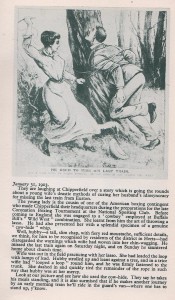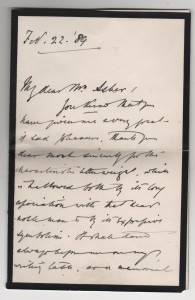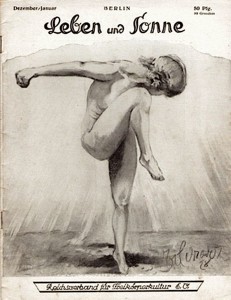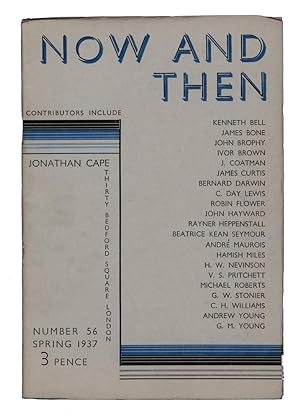
This was a literary magazine published sporadically by Jonathan Cape to promote their own new books.
The idea of such a magazine is unusual, to say the least. Your Jotter is not familiar with any other periodical of this type ( though doubtless there must be one or two) , and it is certainly sneaky to design a magazine to look almost exactly like an independent literary review, rather than a book promotion. The name of the publisher does appear on the cover of the Winter 1936 issue, which we found in our archive at Jot HQ, and in the case of The Book of Margery Kempe, the name ‘ Jonathan Cape’ appears under the blurb in an advertising panel in this issue , but in every other advert in the magazine the publisher’s name is absent, as indeed it is in every review of the books. This is surely misleading to everyone reading the magazine except those who were familiar with it and its aims. A casual reader picking up a copy of Now and Then from a bookstall back in 1936 would conclude that here was yet another literary review and only on close inspection would he or she perhaps be suspicious of its independence. The inclusion of the words ‘Jonathan Cape’ on every advert and in every review would have immediately given the game away. However, any reader sufficiently impressed by a review to seek out the books in a store might easily be offended at being taken in by a blatant piece of puffery. I wonder if Jonathan Cape lost any customers this way. Few would have expected a reputable and long established publisher, such as John Murray, to indulge in such chicanery. But the comparatively recently founded Jonathan Cape, which had begun in 1921, was evidently keen to boost its sales.
The trick, which probably began in the company’s marketing department, originated with the first issue of Now and Then in the 1920s, but was further enhanced in the ‘thirties when it adopted the art deco cover style of Geoffrey Grigson’s New Verse, with its trendy sans serif font. Up to this point Now and Then had used the conventional roman font for its cover. However, the main text and back cover remained resolutely Roman throughout its existence.
To their credit, the people at Jonathan Cape did not choose many of their own authors as reviewers. In this Winter 1936 issue, only Muriel Stuart could be classed as such. Most of the others were under fifty, although there were few older , well-known authors , such as Winston Churchill, William Beach Thomas and Grant Richards. Most were well known literary figures , although one or two, such as short story writer and novelist L. A. Pavey, James Curtis, a screenwriter and novelist, best known for ‘They Drive by Night’, and Muriel Stuart, a poet and writer on gardening, were less eminent.
Continue reading


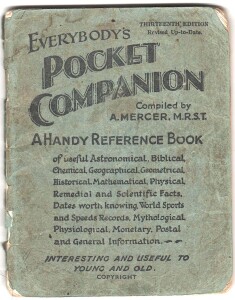
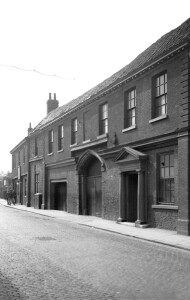
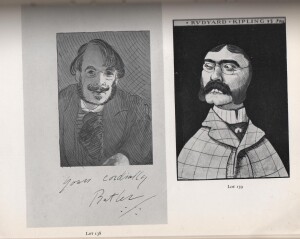
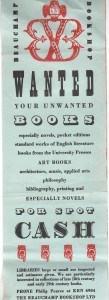 Beauchamp Bookshop of 15a Harrington Road, which was once located by South Kensington station in SW London. Its most striking quality is the boldness of the two colours ( red and black) used for the various period typefaces on display. To someone who grew up in the Swinging Sixties, when designers took inspiration from Victorian (and even older) typefaces and decorative flourishes, it could date from that time. However, the telephone number featured (KEN 6904) might quite equally suggest a slightly earlier date, though the fact that the all-number system began in London in 1966 doesn’t help us much. Some specialist magazines devoted to design, such as Signatureand the Penrose Magazine, were experimenting with typefaces in the forties and fifties. Indeed, the fact that the Beauchamp Bookshop wished to buy books on bibliography and printing suggests that the owner, Mr Philip Pearce, had an active interest in book design. It is telling too that his special need to acquire ‘ late 18thand early 19thcentury books ‘ betrayed a fondness for well printed and well designed books from this pioneering era of fine printing.
Beauchamp Bookshop of 15a Harrington Road, which was once located by South Kensington station in SW London. Its most striking quality is the boldness of the two colours ( red and black) used for the various period typefaces on display. To someone who grew up in the Swinging Sixties, when designers took inspiration from Victorian (and even older) typefaces and decorative flourishes, it could date from that time. However, the telephone number featured (KEN 6904) might quite equally suggest a slightly earlier date, though the fact that the all-number system began in London in 1966 doesn’t help us much. Some specialist magazines devoted to design, such as Signatureand the Penrose Magazine, were experimenting with typefaces in the forties and fifties. Indeed, the fact that the Beauchamp Bookshop wished to buy books on bibliography and printing suggests that the owner, Mr Philip Pearce, had an active interest in book design. It is telling too that his special need to acquire ‘ late 18thand early 19thcentury books ‘ betrayed a fondness for well printed and well designed books from this pioneering era of fine printing.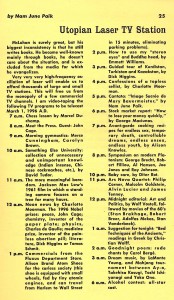
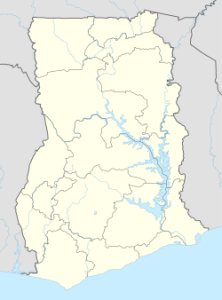
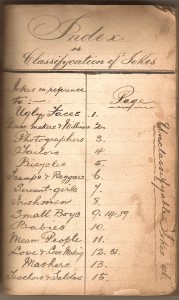 Found at Jot HQ the other day a small scrapbook containing pasted in humorous cuttings from magazines and newspapers that once belonged to the late prankster Jeremy Beadle (1948 – 2008). The date 1897 on the cover was very likely the year in which the compilation was begun, since many of the jokes and anecdotes are clearly of a later date. The high quality of much of the material strongly suggests that the compiler may have been a comedian of some sophistication who was prepared to devote a long period in search of the best gags.
Found at Jot HQ the other day a small scrapbook containing pasted in humorous cuttings from magazines and newspapers that once belonged to the late prankster Jeremy Beadle (1948 – 2008). The date 1897 on the cover was very likely the year in which the compilation was begun, since many of the jokes and anecdotes are clearly of a later date. The high quality of much of the material strongly suggests that the compiler may have been a comedian of some sophistication who was prepared to devote a long period in search of the best gags.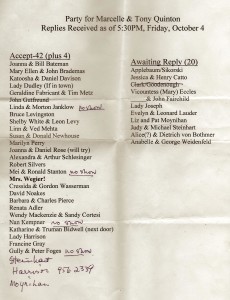 Found among papers at Jot HQ ( heaven knows where it came from ) is this printed list of the good and great ( some not so good) who were invited by a friend or friends to attend a party for the philosopher (Lord)
Found among papers at Jot HQ ( heaven knows where it came from ) is this printed list of the good and great ( some not so good) who were invited by a friend or friends to attend a party for the philosopher (Lord)  The front part is a short record of travels in Germany and Belgium in which the anonymous male diarist, who is accompanying his mother, at one point tells us that he was born in 1802, is very scathing about the appearance of most of his travelling companions. In one instance he remarks that the young son of the parson in the party ‘seemed to be as ugly as his father and as vulgar as his cousin’. He is singularly unimpressed by most of the foreigners he encounters along the way. For instance, he notes that his fellow diners at the Table d’Hote, were ‘12 disgusting looking Germans who luckily eat enormously & spoke little ‘. The following evening diners at the same table were’ rather more disgusting in their appearance & manner of eating than the day before ‘. Predictably, he is also critical of the meals he is obliged to eat and the inns that serve and accommodate him. In one inn he accuses the landlord of serving him a dish of greyhound puppy. Our diarist certainly places himself above the common lot. He seems knowledgeable about art and is a little snooty regarding the collections he views, suspecting that most of the paintings were copies from the masters. More positively, he is often ecstatic about the scenery and buildings he encounters and he particularly praises cathedrals and castles. We yearn for more, but unfortunately, the diary stops abruptly after thirty pages.
The front part is a short record of travels in Germany and Belgium in which the anonymous male diarist, who is accompanying his mother, at one point tells us that he was born in 1802, is very scathing about the appearance of most of his travelling companions. In one instance he remarks that the young son of the parson in the party ‘seemed to be as ugly as his father and as vulgar as his cousin’. He is singularly unimpressed by most of the foreigners he encounters along the way. For instance, he notes that his fellow diners at the Table d’Hote, were ‘12 disgusting looking Germans who luckily eat enormously & spoke little ‘. The following evening diners at the same table were’ rather more disgusting in their appearance & manner of eating than the day before ‘. Predictably, he is also critical of the meals he is obliged to eat and the inns that serve and accommodate him. In one inn he accuses the landlord of serving him a dish of greyhound puppy. Our diarist certainly places himself above the common lot. He seems knowledgeable about art and is a little snooty regarding the collections he views, suspecting that most of the paintings were copies from the masters. More positively, he is often ecstatic about the scenery and buildings he encounters and he particularly praises cathedrals and castles. We yearn for more, but unfortunately, the diary stops abruptly after thirty pages.
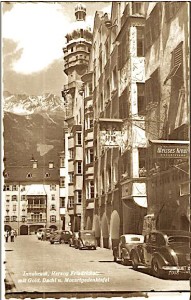
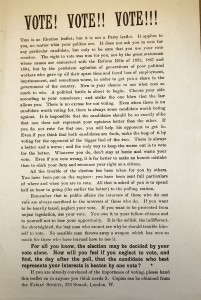

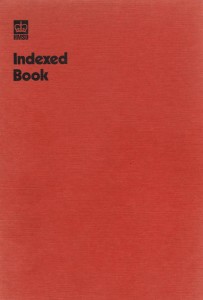 Most of the Common-Place books you find in auctions or second-hand bookshops date from the nineteenth century—usually before about 1860—and are dull, dull, dull! They invariably contain passages from history books, books of sermons, and extracts from poems by Felicia Hemans and Robert Southey. Often they are illustrated by amateurs who like to think they can draw. Occasionally there are exceptions to this rule, but these rarely surface. So it’s nice in this Age of the Internet to find a Common –Place book that contains some information that is not always easy to find using Google. Such is the volume that we at Jot HQ discovered in a box of ephemera the other day.
Most of the Common-Place books you find in auctions or second-hand bookshops date from the nineteenth century—usually before about 1860—and are dull, dull, dull! They invariably contain passages from history books, books of sermons, and extracts from poems by Felicia Hemans and Robert Southey. Often they are illustrated by amateurs who like to think they can draw. Occasionally there are exceptions to this rule, but these rarely surface. So it’s nice in this Age of the Internet to find a Common –Place book that contains some information that is not always easy to find using Google. Such is the volume that we at Jot HQ discovered in a box of ephemera the other day.